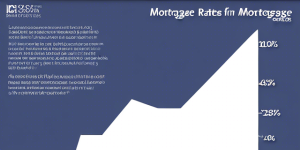Navigating Mortgage Rates for Investment Properties 2024

Investing in real estate can be a lucrative endeavor, but securing the right financing is crucial to maximizing your returns. When it comes to investment properties, mortgage rates can differ significantly from those for primary residences. In this comprehensive guide, we’ll explore the nuances of mortgage rates for investment properties, equipping you with the knowledge to make informed decisions and achieve your investment goals.
Understanding Investment Property Mortgage Rates
Before we dive into the details, let’s first understand what sets investment property mortgage rates apart from those for primary residences.
Lenders typically consider investment properties as higher-risk investments compared to owner-occupied homes. This increased risk stems from the potential for higher vacancy rates, tenant issues, and the possibility that the borrower may prioritize their primary residence over the investment property in times of financial hardship.
As a result, lenders often charge higher interest rates and require more stringent qualifications for investment property loans to offset this perceived risk.
Why Higher Rates for Investment Properties?

- Higher Risk: As mentioned earlier, lenders view investment properties as riskier investments due to the potential for vacancies and tenant-related issues.
- Higher Down Payment Requirements: Lenders typically require a larger down payment for investment properties, ranging from 20% to 30% or more, to mitigate their risk exposure.
- Stricter Debt-to-Income Ratios: Lenders often have stricter debt-to-income ratio requirements for investment property loans, ensuring borrowers have sufficient income to cover all their debt obligations.
- Limited Loan Options: Investment property loans may have fewer loan program options available compared to loans for primary residences, which can further drive up the cost of financing.
Despite the higher rates and stricter requirements, investing in real estate can still be a profitable endeavor if you carefully weigh the costs against the potential returns.
Factors Affecting Investment Property Mortgage Rates

While investment property mortgage rates tend to be higher than those for primary residences, several factors can influence the specific rate you’ll be offered. Understanding these factors can help you navigate the process more effectively and potentially secure better terms.
1. Credit Score
Your credit score is one of the most significant factors lenders consider when determining your mortgage rate. Generally, higher credit scores result in lower interest rates, as they indicate a lower risk of default.
For investment property loans, lenders often require a higher minimum credit score than they would for a primary residence. Maintaining a good credit score can go a long way in securing a more favorable rate.
2. Loan-to-Value Ratio (LTV)
The loan-to-value ratio (LTV) represents the percentage of the property’s value that you’re borrowing. A higher LTV is considered riskier for the lender, as it leaves less equity in the property.
For investment properties, lenders typically prefer a lower LTV, often requiring a down payment of 20% to 30% or more. The lower the LTV, the lower the perceived risk for the lender, which can result in a better mortgage rate.
3. Debt-to-Income Ratio (DTI)
Your debt-to-income ratio (DTI) is another critical factor that lenders consider. This ratio compares your monthly debt obligations (including the proposed mortgage payment) to your gross monthly income.
Lenders often have stricter DTI requirements for investment property loans, as they want to ensure you have sufficient income to cover all your debt payments, including those associated with the investment property.
A lower DTI can improve your chances of securing a more favorable mortgage rate, as it demonstrates your ability to manage your debt obligations effectively.
4. Property Type and Location
The type of investment property you’re purchasing and its location can also influence the mortgage rate you’ll be offered. For example, properties in high-demand areas or those with strong rental potential may be viewed as lower-risk investments, potentially resulting in better rates.
Conversely, properties in areas with high vacancy rates or those that are considered less desirable may be viewed as higher-risk, leading to higher mortgage rates.
5. Occupancy Status
Lenders often consider the occupancy status of the investment property when determining mortgage rates. If the property will be occupied by a tenant immediately after purchase, it may be viewed as a lower risk, potentially resulting in a slightly better rate.
However, if the property will be vacant initially or used as a vacation rental, lenders may perceive a higher risk and adjust the mortgage rate accordingly.
Types of Investment Property Mortgage Loans

When it comes to financing an investment property, you’ll have several loan options to choose from. Each option has its own unique requirements, terms, and rates, so it’s essential to understand the differences to make an informed decision.
1. Conventional Loans
Conventional loans are those that conform to the guidelines set by government-sponsored enterprises (GSEs) like Fannie Mae and Freddie Mac. These loans are typically available for investment properties, but with higher interest rates and stricter requirements compared to loans for primary residences.
For conventional investment property loans, you’ll generally need a minimum credit score of 620 or higher, a down payment of at least 20%, and a debt-to-income ratio below 45%.
2. Portfolio Loans
Portfolio loans are those that are originated and held by individual lenders rather than being sold to GSEs like Fannie Mae or Freddie Mac. These loans often have more flexible guidelines and can be tailored to specific investment property scenarios.
However, portfolio loans may come with higher interest rates and stricter requirements, such as larger down payments or higher credit score minimums.
3. Non-Qualified Mortgage (Non-QM) Loans
Non-Qualified Mortgage (Non-QM) loans are those that don’t meet the strict underwriting criteria set by the Consumer Financial Protection Bureau (CFPB) for Qualified Mortgages (QM). These loans are often used for investment properties and can accommodate borrowers with unique financial situations or properties that don’t fit traditional mortgage guidelines.
Non-QM loans may have higher interest rates and require larger down payments, but they can be a viable option for investors who don’t qualify for conventional or portfolio loans.
4. Commercial Loans
If you’re investing in a larger multi-unit property (typically five or more units), you may need to pursue a commercial loan. These loans are designed specifically for income-producing properties and have different underwriting criteria than residential loans.
Commercial loans often require a higher down payment (typically 20% to 30% or more), and the interest rates can be higher than residential investment property loans. However, they can provide the necessary financing for larger-scale investment properties.
5. Hard Money Loans
Hard money loans are short-term, asset-based loans that are typically used for fix-and-flip projects or other real estate investments where traditional financing may not be available. These loans are secured by the value of the property itself, rather than relying heavily on the borrower’s credit or income.
Hard money loans tend to have higher interest rates and stricter terms, making them a more expensive financing option. However, they can be useful for investors who need quick access to capital for a short-term project.
When exploring these loan options, it’s crucial to carefully consider the associated costs, including interest rates, fees, and down payment requirements, to ensure the investment property aligns with your overall financial goals and investment strategy.
Strategies to Secure Better Mortgage Rates for Investment Properties

While mortgage rates for investment properties are generally higher than those for primary residences, there are several strategies you can employ to secure better rates and maximize your investment returns.
1. Improve Your Credit Score
As we’ve discussed, your credit score plays a significant role in determining the mortgage rate you’ll be offered. Improving your credit score can potentially save you thousands of dollars over the life of the loan.
To improve your credit score, focus on paying all your bills on time, reducing your overall debt load, and monitoring your credit reports for any errors or discrepancies that need to be addressed.
2. Increase Your Down Payment
A larger down payment can not only reduce the amount you need to borrow but can also demonstrate to lenders that you have more “skin in the game.” This can result in a lower perceived risk, potentially leading to better mortgage rates.
If possible, aim for a down payment of at least 20% to 30% for investment properties, as this can significantly improve your chances of securing a favorable rate.
3. Explore Lender Options
Not all lenders have the same underwriting criteria or rate offerings for investment property loans. It’s essential to shop around and compare rates from multiple lenders, including banks, credit unions, and online lenders.
Some lenders may specialize in investment property loans or have more flexible guidelines, potentially resulting in better rates or terms for your specific situation.
4. Consider a Portfolio Loan
As mentioned earlier, portfolio loans can offer more flexibility and customization than conventional loans.
5. Leverage Your Investment Property’s Potential
Lenders will evaluate the potential rental income and cash flow generated by your investment property when determining the mortgage rate. Properties with strong rental demand and the ability to generate consistent cash flow may be viewed as lower-risk investments, potentially resulting in better mortgage rates.
To leverage this, be prepared to provide detailed information about the property’s rental history (if applicable), market rent rates, and projected cash flow analysis. This can demonstrate to lenders that the property has the potential to generate sufficient income to cover the mortgage payments and associated expenses.
6. Build a Relationship with a Local Lender
Establishing a strong relationship with a local lender can be beneficial when seeking investment property financing. Local lenders often have a better understanding of the real estate market in their area and may be more willing to work with you on customized loan solutions.
Building a solid rapport and demonstrating your investment experience and financial responsibility can go a long way in securing better rates and terms for your investment property loans.
7. Explore Alternative Financing Options
While traditional mortgage loans are the most common financing option for investment properties, it’s worth exploring alternative financing options that may better suit your specific needs and goals.
For example, you could consider a home equity line of credit (HELOC) or a cash-out refinance on an existing property to fund your investment property purchase. These options can provide access to lower interest rates and potentially more favorable terms.
Additionally, you could explore crowdfunding platforms or real estate investment partnerships, which can allow you to pool resources with other investors and potentially secure better financing terms through collective bargaining power.
Mortgage Insurance for Investment Properties
When financing an investment property, you may encounter the requirement for mortgage insurance, similar to loans for primary residences. Mortgage insurance protects the lender in case the borrower defaults on the loan, and it’s typically required when the down payment is less than 20%.
However, the mortgage insurance requirements and premiums for investment properties can differ from those for primary residences.
Private Mortgage Insurance (PMI)
For conventional investment property loans with a down payment of less than 20%, lenders will typically require private mortgage insurance (PMI). The PMI premiums for investment properties can be higher than those for primary residences, reflecting the increased risk perceived by lenders.
Lender-Paid Mortgage Insurance (LPMI)
Some lenders may offer lender-paid mortgage insurance (LPMI) as an alternative to traditional PMI for investment property loans. With LPMI, the lender pays the mortgage insurance premium upfront, and the cost is typically built into the interest rate of the loan.
While LPMI can eliminate the need for ongoing PMI payments, it’s essential to carefully evaluate the overall costs and potential long-term implications, as the higher interest rate may result in higher overall costs over the life of the loan.
Alternative Mortgage Insurance Options
In some cases, lenders may accept alternative forms of mortgage insurance for investment properties, such as a second mortgage or a personal asset pledge. These options can help you avoid traditional PMI or LPMI, but they come with their own set of risks and requirements.
It’s crucial to thoroughly understand the mortgage insurance requirements and options for your specific investment property loan and to carefully weigh the costs and benefits of each option to make an informed decision.
Refinancing Investment Property Mortgages
As an investor, refinancing your investment property mortgage can be a valuable strategy to take advantage of lower interest rates, access equity, or consolidate debt. However, the process and requirements for refinancing an investment property mortgage can differ from refinancing a primary residence.
Reasons to Refinance an Investment Property Mortgage
- Lower Interest Rates: If mortgage rates have dropped since you initially financed your investment property, refinancing can help you secure a lower interest rate, potentially saving you thousands of dollars over the life of the loan.
- Access Equity: If your investment property has appreciated in value, you may be able to tap into that equity through a cash-out refinance. This can provide funds for additional investments, renovations, or other financial goals.
- Consolidate Debt: Refinancing can allow you to consolidate higher-interest debt, such as credit card balances or personal loans, into a single, potentially lower-interest mortgage payment.
- Adjust Loan Terms: Refinancing can also provide an opportunity to adjust your loan terms, such as switching from an adjustable-rate mortgage (ARM) to a fixed-rate mortgage, or extending the loan term to lower your monthly payments.
Requirements for Refinancing Investment Property Mortgages
When refinancing an investment property mortgage, lenders typically have stricter requirements compared to refinancing a primary residence. Some common requirements include:
- Equity Threshold: Lenders often require a higher equity threshold for investment property refinances, typically 25% to 30% or more, to mitigate their risk exposure.
- Credit Score: A higher credit score may be required for investment property refinances, with some lenders requiring a minimum score of 680 or higher.
- Debt-to-Income Ratio: Lenders will scrutinize your debt-to-income ratio more closely, ensuring you have sufficient income to cover all your debt obligations, including the new mortgage payment.
- Rental Income Documentation: If you’re relying on rental income to qualify for the refinance, you’ll need to provide documentation such as current leases, rent rolls, and proof of consistent rental income.
- Property Appraisal: An appraisal will be required to determine the current market value of your investment property and ensure you meet the equity requirements for the refinance.
Timing Your Investment Property Refinance
Timing your investment property refinance can be crucial to maximizing the benefits and minimizing costs. Here are some key considerations:
- Interest Rate Trends: Monitor interest rate trends and try to refinance when rates are at or near historic lows to secure the most favorable terms.
- Break-Even Point: Calculate the break-even point, which is the point at which the savings from the lower interest rate offset the costs of refinancing (closing costs, fees, etc.). This will help you determine if refinancing makes financial sense.
- Loan Seasoning: Some lenders may have seasoning requirements, meaning you’ll need to have held the existing mortgage for a certain period (e.g., 6 months to a year) before refinancing.
- Prepayment Penalties: Check if your current mortgage has any prepayment penalties that could offset the potential savings from refinancing.
By carefully considering these factors and working with a knowledgeable lender, you can navigate the investment property refinance process effectively and potentially unlock significant cost savings or access to equity for your investment portfolio.
Conclusion
Securing the right mortgage for your investment property is a critical step in ensuring the profitability and long-term success of your real estate investment strategy. While mortgage rates for investment properties are generally higher than those for primary residences, understanding the factors that influence these rates and employing strategic approaches can help you secure more favorable terms.
By maintaining a strong credit score, increasing your down payment, exploring lender options, and leveraging your investment property’s potential, you can position yourself to secure better mortgage rates and maximize your returns. Additionally, exploring alternative financing options and considering refinancing opportunities can provide further avenues for optimizing your investment property financing.
Navigating the world of investment property mortgages requires diligence, knowledge, and a willingness to explore various strategies. By arming yourself with the information in this comprehensive guide, you’ll be well-equipped to make informed decisions and achieve your investment goals with confidence.
FAQs
1. Can I use the rental income from my investment property to qualify for the mortgage?
Yes, lenders will typically consider the rental income generated by your investment property when evaluating your ability to make the mortgage payments. However, you’ll need to provide documentation such as current leases, rent rolls, and proof of consistent rental income to substantiate the income claim.
2. How much cash reserves will I need for an investment property mortgage?
Lenders often require borrowers to have additional cash reserves when financing an investment property. The amount can vary, but many lenders require at least six months’ worth of mortgage payments in reserves to cover potential vacancies or unexpected expenses.
3. Can I finance multiple investment properties with the same lender?
It is possible to finance multiple investment properties with the same lender, but the requirements and terms may become more stringent as you add more properties to your portfolio. Lenders will evaluate your overall risk exposure and may impose higher down payment requirements or debt-to-income ratio thresholds.
4. Are there any special considerations for financing vacation rental properties?
Yes, financing a vacation rental property can come with additional considerations. Lenders may view these properties as higher-risk investments due to potential seasonality and vacancy rates. You may need to provide detailed income projections and have a larger down payment to secure financing for a vacation rental property.
5. Can I use a home equity line of credit (HELOC) to finance an investment property?
While it’s possible to use a home equity line of credit (HELOC) to finance an investment property, there are some important considerations to keep in mind:
Pros:
- Potentially lower interest rates than traditional investment property loans
- Flexible access to funds as needed
- Interest may be tax-deductible (consult a tax professional)
Cons:
- Your primary residence is used as collateral, putting it at risk
- Lenders may have strict loan-to-value (LTV) and debt-to-income (DTI) requirements
- Interest rates are typically variable and can fluctuate over time
If you do decide to use a HELOC for an investment property, be sure to carefully evaluate the risks and potential implications. Lenders may have specific guidelines or restrictions on using a HELOC for investment property purchases, so it’s essential to discuss your plans with them upfront.
Additional FAQs:
6. How can I find lenders that specialize in investment property loans?
There are several ways to find lenders that specialize in investment property loans:
- Ask for referrals from other real estate investors or professionals in your network.
- Check with local banks and credit unions, as some may have dedicated investment property lending programs.
- Research online lenders that specialize in investment property financing.
- Look for lenders that advertise their investment property loan offerings.
It’s also a good idea to attend local real estate investment club meetings or networking events, where you can connect with lenders who cater to investors in your area.
7. Can I deduct mortgage interest on an investment property from my taxes?
Yes, the mortgage interest paid on an investment property is generally tax-deductible. This can be a significant advantage for investors, as it can help offset some of the costs associated with owning and financing the property.
However, it’s important to consult with a qualified tax professional to ensure you understand the specific rules and limitations around deducting mortgage interest on investment properties.
8. Should I consider an adjustable-rate mortgage (ARM) for my investment property?
Adjustable-rate mortgages (ARMs) can be an option for investment property financing, as they may offer lower initial interest rates compared to fixed-rate mortgages. This could potentially provide more favorable cash flow in the short term.
However, ARMs also come with the risk of rising interest rates over time, which could increase your monthly mortgage payments and potentially impact your investment property’s profitability.
Whether an ARM is a suitable option for your investment property will depend on various factors, including your investment strategy, risk tolerance, and plans for holding or selling the property in the future. It’s advisable to carefully evaluate the potential risks and benefits before deciding on an ARM.
9. How often can I refinance an investment property mortgage?
There are generally no specific limits on how often you can refinance an investment property mortgage. However, each time you refinance, you’ll need to go through the full underwriting process, which includes credit checks, income and asset verification, and potentially an appraisal of the property.
It’s also important to consider the costs associated with refinancing, such as closing costs, origination fees, and potential prepayment penalties on your existing mortgage. These costs can add up quickly, so it’s essential to ensure that the potential savings from refinancing outweigh the upfront costs.
Additionally, some lenders may have their own guidelines or requirements regarding the frequency of refinancing or seasoning periods (the amount of time you must hold the existing mortgage before refinancing).
10. Are there any special considerations for financing investment properties in different states or regions?
Yes, there can be regional variations in investment property financing requirements and regulations. Some factors to consider include:
- State-specific lending laws and regulations
- Local real estate market conditions and trends
- Lender guidelines or overlays specific to certain geographic areas
- Property types or zoning restrictions that may impact financing
It’s generally a good idea to work with a lender that has experience in the specific area where your investment property is located. They will have a better understanding of any regional nuances or considerations that may impact the financing process.
Additionally, be prepared to provide detailed market data and analysis for the area to help support your investment property financing application.

